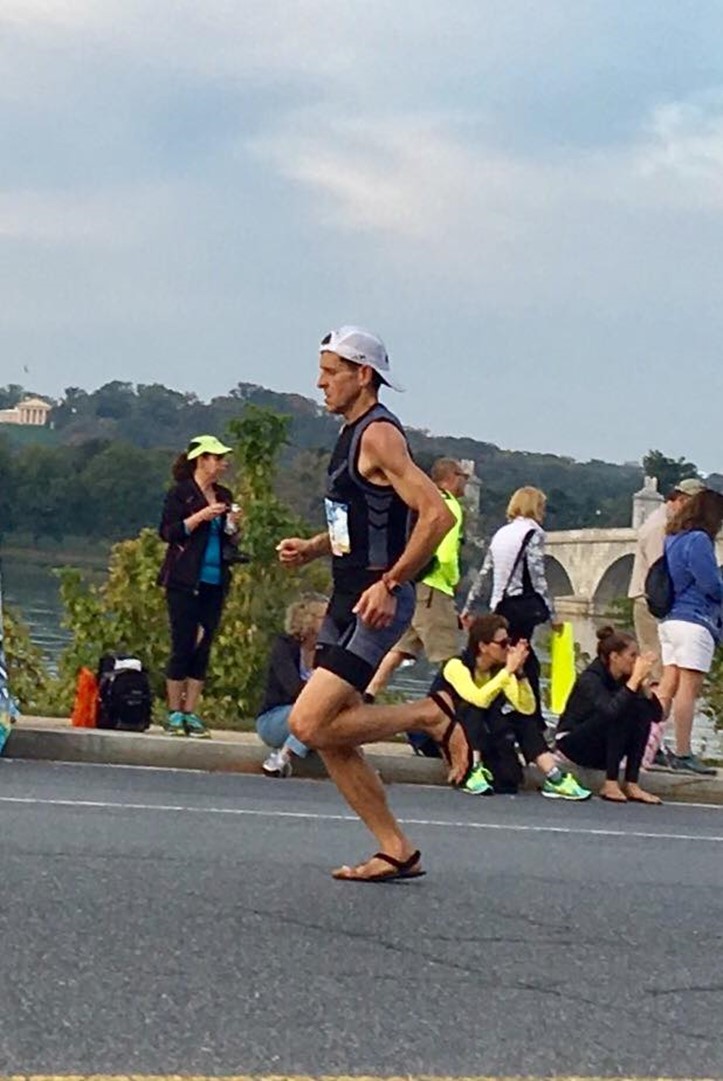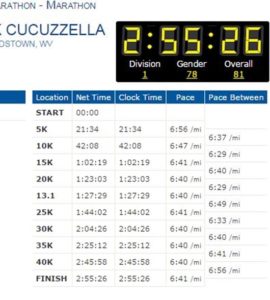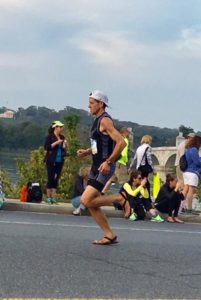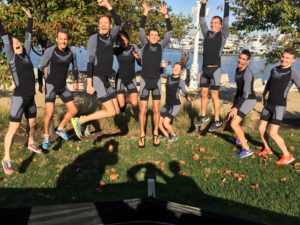Mark Cucuzzella MD, Professor West Virginia University School of Medicine, LtCol US Air Force
2006 and 2011 Air Force Marathon Champion; Co-Race Director Freedom’s Run
Welcome to the 2017 Marine Corps Marathon! As part of the US Air Force Running Team, my Patriotic Marathon ritual includes 22 Boston Marathons and 16 consecutive, 23 Marine Corps Marathons and 15 consecutive, and 17 Air Force Marathons. The average time of these 60 plus finishes of these three races is a hair above 2:40. With age (51 years old now) and a busy life the times are slowing a bit but the joy of running only increases. I feel fortunate to be healthy and have been running pain free for over 17 years since relearning how to run after foot surgeries. This will be Marine Corps number 24 and defending my 50-55 age group title 🙂
Here are the nice even splits from a warm day last year while running in Shamma sandals.
As you enter the weekend of the Marine Corps Marathon here are a few visualizations to help you set your plan. Running your best 10k is mostly about fitness. Running your best marathon or half is part art, science, guts, and faith in what you can do. It is never too late to learn new things and share with others and like you all continuing the journey and just this year continued a streak of 30 years sub 3 hour marathons which is the longest active streak and 3 more years to have the record (my kids will hold me to it)
For starters, remember when you are on the line Sunday morning you are already over 95% done. That is the training you have done to prepare. So the race is the final fun lap in the company of others and with bands on the course. As you enter the week prior to the race here are a few strategies to help you set your plan. The best analogy I can think of is this: if you have trained your body properly with the right mix of aerobic level training and some up tempo stuff in recent weeks, you have built your efficient hybrid engine ready to race the marathon. Many of you have driven in a Prius and watched the subtle shifts between gas and electric on the dashboard. You do not perceive these shifts. Your engines (muscles) run on a mixture of gas (sugars) and electric (fats). Utilizing gas or electric power depends on the effort. This is why slow aerobic training is critical for marathon success, you build a massive electric (fat burning) engine.
Races lasting longer than 90 minutes require you to use fat as fuel. So for half marathoners running above this time the same strategies apply, just modify this article for the half when distances apply. You are starting the race with one gallon in the gas tank- assuming you have eaten a nice meal the night before with a light breakfast top off. If you race in all gas mode, your engines will run about 90 minutes at a strong pace….then you are out of gas. If your effort is mostly electric you can run for hours, but not as swiftly.
With the correct effort you (1) will use the proper fuel mix and you will be efficient for duration of your event and (2) you can even do some topping off along the way. Too hard early you will sabotage the day by not only depleting the gas but also shunting all blood flow to working muscles, thereby not allowing the aid station top offs to assist.
Running utilizes about 1kcal/Kg/Km. This assumes you are a really efficient runner and the conditions ideal (rarely are either of these the case). So for a lean marathoner of 80 kg you need about 3360 kcals (80kg x 42 km) to make it. The gas is the glucose utilizing pathway. Even fully carbo loaded, your stored liver glycogen (300-500kcal), muscle glycogen (1000-1500kcal), and blood glucose (less than 20 kcal). Glucose is easy to access for ready energy but adds up to less than 2000kcal. The fat utilizing pathway is the electric. In marathons (and slower half marathons) you must be in hybrid mode to make it. Hybrid is where your energy (ATP) is coming from both fuel sources. Conserving the gas and using electric early in the race is critical.
Many runners are in great “10k shape” (an all gas event), run their marathon in the all gas mode….and crash. Glycogen sparing strategy need not apply in races of less than an hour as long as you had a good pre-event meal to fill the tank. In marathons and ultras, top end anaerobic fitness matters little and can only be applied very near the finish. Glucose gives 36 ATP per molecule with a limited supply, fat 200-400 ATP per molecule and an unlimited supply. You must tap into the fat burning tank. Now you know how a bird can migrate 7000 miles without an aid station. It’s all about the pace.
Another key to teaching your body how to burn fat and to maximize aerobic development is to not eat before or during your long runs. If you are reading this for the first time before this week’s race then apply to your next marathon or half marathon. Your body adapts to exposures and if sugar is constantly accessible it will not learn how to burn fat. You also want to convert your fast twitch fibers to make them as “red” (oxidative) as possible. Easy and moderate effort long runs of 2 hours in a fasted state will drain the slow twitch fibers (“red” fibers) of glycogen and force more capillarization of the fast twitch (mix “white”/”red”) fibers, making them more “red”. You are doing “speed work” by running slow with this method, making the powerful fast twitch fibers aerobic. Distance runners in events from 800 meters to marathons through generations have all trained this way. This is part of the Lydiard method. Only recently have we been convinced we need lots of sugar before and during long runs. Race day is different as you are going for performance, not creating adaptations. More on this later.
So how do you know you are running in your best hybrid mode?
This is difficult because the body sense at this level (Aerobic Threshold) is not as profound as Lactate Threshold (or Anaerobic Threshold). A slight increase from your optimal pace will switch you from hybrid to all gas without you realizing it. The effects are felt miles later. Breathing comfortably, even through your nose, and being able to talk is a good indicator of proper pace. Charging and surging early will tap your gas quickly.
You must rehearse in training. I focus on relaxation and belly breathing. If able to breathe through my nose then I’m hybrid. If breathing faster, I’m using mostly glucose as fuel. Belly breathe- allow lower belly to blow up like a beach ball on inhalation as your powerful diaphragm contracts. You will fill the lower lung areas where oxygen exchange occurs. Notice the breathing efforts of those around you. Many are rapid breathing. They will suffer somewhere past half way. Practice nasal breathing, it forces belly breathing and prevents you from running in too high a gear. Nasal breathing also allows CO2 to rise naturally to assist in offloading the oxygen to the tissues. Blowing off CO2 binds the oxygen to the hemoglobin, inhibiting offload to the tissues. Rehearse complete relaxation from the top down- eyes, jaw, shoulders. Allow your legs to relax and extend behind you. Your core is controlled and your legs are the springs. Find you own cue for this. If you use a Heart Rate Monitor in training strongly consider one during the event.
Save energy for the later stages of the race, this is where things can get tough. Remember, if you feel really good in the early stages and feel like you want to speed up….DON’T. It is a marathon and you should feel good in the early miles. Speed up only when you can “smell the barn”, this occurs when you are about 5 k to go. In a marathon, the last 3-4 miles you will be mostly gas to maintain the same speed as fatigue sets in, your springs lose bounce, and heart rate rises. The breathing is usually increased a bit- that is OK. Still stay relaxed and use the cues that you have rehearsed to keep your form.
Now a little on running style. Land softly, especially on the early downhills. Focus on good form. I run with a midfoot landing harnessing elastic recoil. Gently landing on and rolling from the heel can work too. Do not overstride with fully extended leg. Focus on posture and hip extension. Your trunk will lean forward just slightly…..think “face forward” and look ahead. Run over the ground not into the ground. I’m never sore after marathons now and feel I can keep doing them until I enter the retirement home. With good form it is “No pain…thank you”. Find a nice rhythm. Races are filled with excitement and distractions. For you there are no distractions, just peace in the moment.
Now for a little on the most important organ for running- your brain. Your brain is the captain of the ship and will always try to protect you. Even at “all on” we are only really using 50-60% of our capacity. The brain likes homeostasis and running 26 miles is counter to this. Assuming you are medically healthy you can play some tricks to outwit your brain which is constantly telling you to slow down or stop. Work around the bad patches with your mind and find a better mental place. You are not “done”. Shift your stride, take a little sugar, run mile to mile, sing a song, smile, relax and slow the breathing. You want to be “parasympathetic”. This is happy land. If your brain tells you the body is in peril, “sympathetic” stress kicks in. This is good for running from a wild animal (a sprint), but not for persistence hunting ( a marathon) .
Your shoes matter too. Make strong consideration to not running in minimalist racers unless you have trained substantially in them and adapted your structure to less foot support and a natural style gait. I advocate gradually adapting all of your training into more minimal and level shoes. If you relax your lower legs and load the springy tendons in your feet and lower legs, these shoes with no heel elevation put you in perfect position to allow natural elastic recoil of plantar fascia, Achilles and lower leg tendons, glutes, and hip flexors. For a library of information of footwear, running form, and biomechanics visit RunRX on http://naturalrunningcenter.com/ or visit http://www.tworiverstreads.com.
Have a course specific plan. This is pretty simple as the course is mostly flat. Relax and warm up on the first uphill in Arlington. The early downhill out of Arlington is fun but if run too hard it can damage your quads….go smooth and easy down the hill. Allow gravity assist you down. Do not overstride and heel hit on the down hills- remember run over the ground not into the ground.
Find your rhythm on the scenic and mostly flat Rock Creek Park section miles 4-8. Revel in the fact that you are not climbing out of Georgetown and around Reservoir as in past years. Do not take the bait and get too excited by the Georgetown crowds. Find a nice rhythm on the peaceful stretch around Hains Point and make sure to get fuel and fluids as rehearsed. This is my favorite part of the race. There are no distractions. Relax head to toe and make sure you are belly breathing. The Blue Mile is along this stretch (Mile 12). Any discomfort you may feel is reduced as you view the pictures of the fallen soldiers and family members holding the flags. Relax and enjoy the tour through the Mall.
Save energy for the 14th St. Bridge, this is where things can get tough- 2 miles of lonely cement and often into the wind. A wonderful feeling is exiting the Bridge and entering Crystal City. Once you are over this bridge you are heading for home. Save energy for the later stages of the race, this is where things can get tough. Again, if you feel really good in the early stages and feel like you want to speed up….DON’T. Now a few extra ways to get from start to finish quicker on the same gallon.
Now a few extra ways to get from start to finish quicker on the same gallon.
- The early downhill out of Arlington is fun but if run too hard it can damage your quads….go smooth and easy down the hill. Allow gravity assist you down. Do not overstride and heel hit on the down hills- remember run over the ground not into the ground.
- Do not sabotage your event by having a large carbohydrate heavy breakfast the morning of the race. This will increase your insulin levels and lock out the ability to burn fat. Fill your glycogen stores by not running and eating adequate amounts of healthy carbohydrates the 3 days prior. Do not overload, you can only store a specific amount. Personally I am insulin resistant with age so do not carbo load and prefer the slow release super starch UCAN the morning of events and on courses where I can leave a bottle or two. I use the Hydrate electrolyte in water during the race. I have adapted to using primarily fat as fuel and want to do this during the race. A light breakfast of mix carb/fat/protein is a good thing as well as your morning coffee if you are a coffee drinker. Click here for a webinar I did with UCAN on “How to be a Better Butter Burner” .
- Do not over drink water. This can lead to a dangerous condition called hyponatremia. See guidelines
- If it is going to be hot read this article I wrote after the steamy 2012 Boston Marathon which was published in the American Medical Athletic Association Journal
- If you can add a little gas along the way then you can go more into gas mode. This helps a little at best. If running too fast or if temperature high you shunt all blood to working muscles and skin to cool so nothing digests. Plus you are burning quickly through the glucose/gas. If you are in hybrid in the early going you can continually add fuel- the key is not only the correct fuel, but the right pace. A gel every hour is easy to digest and tops off the tank. Carry a couple with you at the start. If you do the gels then you can drink water instead of the energy drinks which are often less predictable on the run.
- If you are having a “bad patch” – try to refocus on relaxing, fuel a bit (sometimes a blood glucose drop triggers the sense of doom), and have faith in your training and race plan. Another nice trick is when you hit mile 21 it is not 5 miles to go, it is 4 and change. Mile 22 is 3 and change to go. Just run to the next mile marker and count them down one by one.
- A final tip from 4 time Olympic Trials qualifier Josh Cox who spoke with me before the Air Force Marathon a few years ago. The night before the race make “the invisible man”. Get everything you are going to wear/use the next day set up to put on in the morning. Scrambling to find your number, socks, favorite hat, gels or other item adds stress. Get the outfit laid out on the floor ready to wear, then get some sleep.
The fun of the marathon is that we are always learning and enjoying the adventure of it. We learn from experience, taking chances, and occasional failures. I’ve learned a few things in over 30 years on how to train and race efficiently and economically in the marathon, but still there are uncertainties every time you line up. I learn something new every time. So relax, taper up, and seize the day.
I’d like to especially thank the wonderful volunteers and all who serve in the US Armed Forces.
See you at the start!
Dr. Mark
2016 USAF Running Team and Smilin’ at the Finish
…………………
post run update…..whew 2:59:20
Here is the Grid
Marine Corps Marathon History
Date Age Time
1988 22 2:34:02
1989 23 2:32:41
1990 24 2:31:52
1991 no fall marathon
1992 26 2:36:35
1993 no fall marathon
1994 28 2:31:01
1995 29 Sept- World Military Championships Rome 2:24 10th
1996 30 2:27:20 4th place overall
1997 31 2:35:21
1998 32 Sept- Air Force Marathon 2:34
1999 33 Oct- Chicago Marathon 2:24
2000 34 2:28:55 3rd Place overall
2001 35 Nov- US Marathon Champs@NYC Marathon 2:33
2002 36 2:34:46
2003 37 2:33:37
2004 38 2:39:41
2005 39 2:34:47
2006 40 2:32:45 1st Master
2007 41 2:37:48
2008 42 2:34:48 1st Master
2009 43 2:40:55
2010 44 2:42:07
2011 45 2:43:47
2012 46 2:48:29 1st 45-49
2013 47 2:47:35
2014 48 2:49:49
2015 49 2:55:40
2016 50 2:55:26 1st 50-55
2017 51 2:59:20







Thanks Doc C. for a very insightful and informative write-up/primer for the 42nd MCM and all my future races! I, too, am a fat-adapted runner and UCAN user. I look forward to many more marathons and years of healthy running thanks to so many of your podcasts, articles, and the information/research you continue to pass on to all. Thank you! Semper Fi!
– Scott Armstrong
Maj/USMC
thanks Scott! was a great day out there today